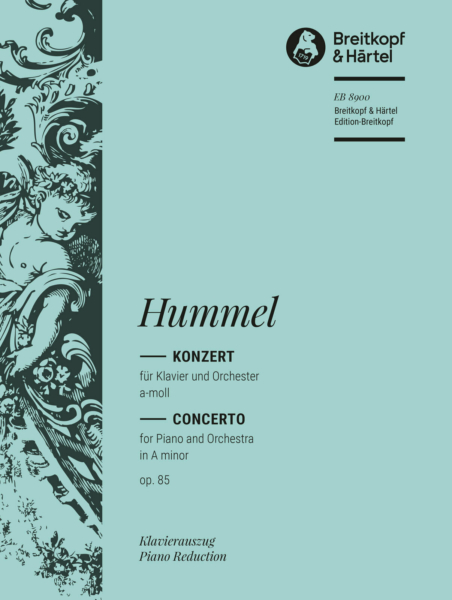Johann Nepomuk Hummel (1778–1837) Klavierkonzert a-moll op. 85
herausgegeben von Andrew Brownell [Klav,Orch] Dauer: 35'
Solo: Klav – 1.2.2.2 – 2.2.0.0 – Pk – Str
Ein erfolgreiches Werk „zwischen den Zeiten“ – 1816 entstanden, häufig aufgeführt und mehrfach gedruckt.
EB 8900 ist in Partitur gedruckt; zur Ausführung werden zwei Exemplare benötigt.
Nachdem Sie die gewünschten Ausgaben in den Warenkorb gelegt haben, können Sie dort die benötigte Stückzahl bei Bedarf noch anpassen.
Johann Nepomuk Hummel knüpft bei Dussek und sichtlich bei Beethoven an, der damals sein fünftes und letztes Klavierkonzert geschrieben hatte, und er beeinflusst andererseits Schumann und Chopin. Dessen e-moll Klavierkonzert op. 11 weist frappierende Ähnlichkeiten mit Hummels Werk auf. Hier erweist sich der Komponist als Wanderer an der Nahtstelle zwischen zwei Epochen, dem in seinem a-moll Klavierkonzert Grenzüberschreitendes gelingt und der damit Weber und Schubert ebenbürtig zur Seite steht.
| 1. Allegro moderato |
| 2. Larghetto |
| 3. Rondo: Allegro moderato |
Johann Nepomuk Hummel komponierte sein a-moll-Klavierkonzert 1816 in Wien, noch bevor er die Stadt verließ, um seine schwierige Stuttgarter Amtszeit anzutreten. Da eine Abschrift von der Hand Jan Václav Voříšeks existiert, der seinerzeit in Wien bei Hummel Unterricht nahm, lässt sich die Entstehung des Werkes zweifelsfrei dieser Periode zuweisen. Im Druck erschienen ist es allerdings erst 1821 bei Steiner in Wien – zu einer Zeit, als Hummel bereits den auf dem Titelblatt des Erstdrucks erwähnten vielversprechenderen Posten des Kapellmeisters in Weimar übernommen hatte. Auf der Titelseite des Erstdrucks findet sich außerdem eine Widmung an die Prinzessin Augusta von Sachsen-Weimar.
Hummels a-moll-Konzert erfreute sich seinerzeit beachtlicher Beliebtheit, und die Ausgabe erfuhr im Laufe des 19. Jahrhunderts zahlreiche Nachdrucke. Es war eines der ersten Stücke, die Robert Schumann mit Friedrich Wieck erarbeitete, und Schumann erzählte Hummel später, dass er ein ganzes Jahr an dem Konzert geübt hätte.
Es ist sehr wahrscheinlich, dass auch Chopin dieses Werk kannte – beinhaltete sein Repertoire doch mehrere Hummelkonzerte und weist sein eigenes e-moll-Konzert (op. 11) doch einige frappierende Ähnlichkeiten zu Hummels Klavierkonzert op. 85 auf.
Das a-moll-Konzert mag insofern „proto-romantisch“ sein, als es manche stilistischen Züge romantischer Klavierkonzerte, insbesondere derjenigen Chopins, bereits ahnen lässt. Hinsichtlich seiner strukturellen Merkmale ist es jedoch fest in der Klassik verwurzelt und weist starke Beethovensche Einflüsse auf. So ist das Schlussrondo – sowohl was die Form, als auch den Charakter des Hauptthema anbelangt – eindeutig dem Schlusssatz aus Beethovens 3. Klavierkonzert verpflichtet. In beiden Finalsätzen findet sich ein lyrisches Seitenthema mit vorwiegend begleitender Funktion, dem jeweils eine fugale Durchführung folgt. Die „martialischen“ punktierten Rhythmen der Hauptthemen des ersten Satzes erinnern außerdem an den Eingangssatz aus Beethovens 5. Klavierkonzert. Dadurch, dass der erste und letzte Satz virtuose Codas beinhalten, ist es im Übrigen auch nicht zwingend notwendig, dem Spieler durch eine Kadenz Gelegenheit zur virtuosen Selbstdarstellung zu geben. Indem Hummel bewusst darauf verzichtet, Platz für eine Kadenz vorzusehen, scheint er eben gerade nicht dem Beispiel von Beethovens 5. Klavierkonzert zu folgen, sondern vielmehr der klassischen Tradition, wie sie erstmalig durch Dusseks Konzerte in den 1790er Jahren begründet wurde.
Einzig beim Larghetto sucht man wohl vergeblich nach einem klassischen Vorläufer. Dessen „fioriturenhafte“ Schreibweise gehört vielmehr einer späteren Zeit an, und es ist gerade dieser durch Ausschmückungen geprägte Habitus, in dem der formende Einfluss Hummels auf Chopin am stärksten zutage tritt.
Andrew Brownell, London, Frühjahr 2015










 Blättern
Blättern